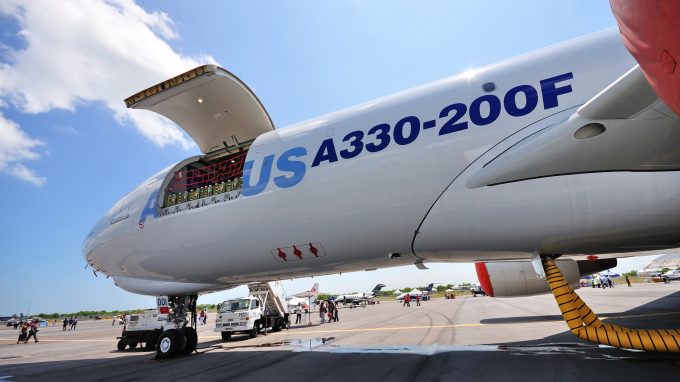Air cargo spot rates hit 2024 peak, while Vietnam becomes a hotspot
Air cargo spot rates have risen to their highest level this year, despite the recent ...
GM: RAISING THE ROOF GGM: IN FULL THROTTLE GZIM: MAERSK BOOST KNIN: READ-ACROSSMAERSK: NOT ENOUGHMAERSK: GUIDANCE UPGRADEZIM: ROLLERCOASTERCAT: HEAVY DUTYMAERSK: CATCHING UP PG: DESTOCKING PATTERNSPG: HEALTH CHECKWTC: THE FALLGXO: DEFENSIVE FWRD: RALLYING ON TAKEOVER TALKODFL: STEADY YIELDVW: NEW MODEL NEEDEDWTC: TAKING PROFIT
GM: RAISING THE ROOF GGM: IN FULL THROTTLE GZIM: MAERSK BOOST KNIN: READ-ACROSSMAERSK: NOT ENOUGHMAERSK: GUIDANCE UPGRADEZIM: ROLLERCOASTERCAT: HEAVY DUTYMAERSK: CATCHING UP PG: DESTOCKING PATTERNSPG: HEALTH CHECKWTC: THE FALLGXO: DEFENSIVE FWRD: RALLYING ON TAKEOVER TALKODFL: STEADY YIELDVW: NEW MODEL NEEDEDWTC: TAKING PROFIT

The much-discussed lack of maindeck capacity in air cargo has given a new lease of life to ageing freighters that seemed headed for oblivion.
However, not every viable cargo plane is being rushed back into action.
Amid a growing shortage of widebody freighters, one aircraft type seems to attract little interest: while operators and forwarders alike lament the lack of large freighters – especially B747s, and passenger 747-400s are a target for conversion into all-cargo configuration – nobody seems to be in a hurry to snap up A330-200Fs.
Witness Etihad’s five-strong A330-200F fleet that has been parked since January; nobody has stepped forward so far with an offer the cash-strapped Middle East carrier can’t refuse.
“If a carrier like Etihad cuts back and divests aircraft, you would expect them to be readily taken up,” said Jonathan McDonald, head analyst of IBA Group
And more recently, reports have surfaced that Qatar Airways is planning to return three A330Fs it leases when their term expires next year. Moreover, there have been suggestions that the Middle East carrier is considering selling the five A330-200Fs it owns.
The airline’s management believes the A330F is useful for opening new markets, but once critical mass has built, the B777-200F offers better economics. This was said in May, when Qatar signed an order for five more 777Fs. Rival Etihad has parked its five A330 freighters, but continues to use its five 777-200Fs.
With eight A330 freighters deployed, Qatar Airways is the second-largest operator of the type – Turkish Airways Cargo has nine A300-200Fs.
If Qatar was to turn its back on A330 freighter operations it would cast a dark cloud over the conversion programme for A330-200s and -300s, for which the airline has been the most vocal advocate. In 2012 it indicated it was looking to covert 15-20 of its A330s in passenger service into all-cargo aircraft.
The global A330 passenger fleet offers ample feedstock for years to come. To date, some 1,400 have been delivered and close to 300 remain on Airbus’s orderbook, meaning the A330 is poised to overtake the 747 as the most ordered widebody, after the B777.
After a slow start, the A330 P2F programme finally got under way last year, with the first A330-300P2F entering service for DHL in December.
Then the skies seemed to brighten for the A330. At the Airline Economics Growth Frontiers conference in Dublin in January, ATSG chief operating officer Richard Corrado and GECAS senior vice-president cargo Rich Greener described the A330-300P2F as a viable competitor once its residual costs came down to a viable level. Atlas Air, which has moved aggressively to build up its B767 freighter contingent, also indicated future interest in the A330 freighter.
For Atlas Air and ATSG, which have been working with Amazon, the A330 would seem a more suitable candidate than for an airline that hauls general cargo. Enquiries from Amazon and UPS has, allegedly, been the main stimulus for Airbus considering an all-cargo version of its A330 neo model.
“The A330 is only good for integrators,” said Stan Wraight, president of Strategic Aviation Solutions International, adding that he believes the type too expensive for general cargo haulage and its “contours are challenging”.
Airbus has aimed the A330 freighter chiefly at the express sector, emphasising its higher volume and number of pallet positions versus the 767. However, even the express parcel carriers have been slow to bite. In a situation where freighters are eagerly snapped up and thrown into business, the A330 seems to have attracted little clamour.
Comment on this article